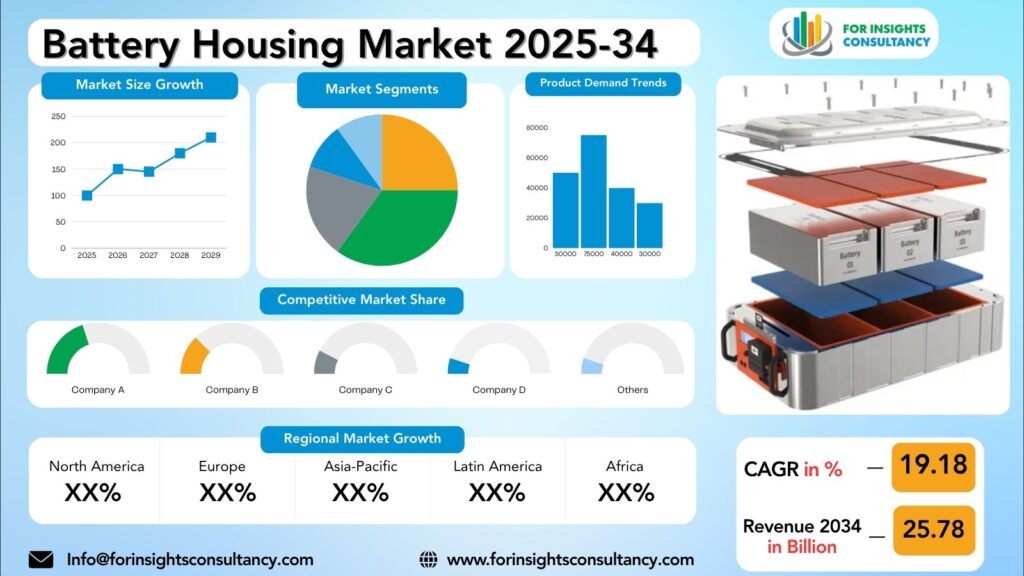
Battery Housing Market Size, Trends Analysis Research Report by Battery Type (Lithium-ion Battery, Nickel-Metal Hydride Battery, Solid-State Battery, Others), by Material Type (Aluminum, Steel, Carbon Fiber Reinforced Polymer (CFRP), Glass Fiber Reinforced Polymer (GFRP), Others), by Vehicle Type, by Application, and By Region Global Market Analysis And Forecast, 2025-2034
Oct-2025 Formats | PDF | Category: Automotive | Delivery: 24 to 72 Hours
Global revenue from the Battery Housing market is high-quality at US$ 6.97 Billion in 2025 and has been up-front to current at a CAGR of 19.18% to reach US$ 25.78 Billion by the end of 2034.
Battery Housing Market: A Comprehensive Overview and Future Developments
In response to a global call to combat climate change by reducing carbon emissions, the demand for electric vehicles and renewable energy storage solutions is driving the growth of the battery housing market. The market overview is an extensive study that shows the present market scenario and the developments propelling the future market.
The battery housing market is flooded with orders stemming from the global rise in electric vehicle sales and the increasing concern for environment conservation. To outshine each other and to attract more customers manufacturers are hustling in innovative technologies to improve the performance and safety of battery housings.
The market is highly engaged in the debate on what kind of material should be used for battery housings to not only make them more energy efficient but also to be able to last longer. The introduction of smart technologies for instant monitoring and diagnostics at the user end is also becoming popular in the industry.
Wearable technologies that can interact wirelessly with the user to give instant feedback on their physical activity and health are the innovations of materials science and manufacturing processes that are driving the battery housing market towards the future. The market is expected to grow enormously as stricter emission regulations come into effect and necessities for energy storage solutions increase.
To sum up, the battery housing market is set to be significantly supplemented with a growing demand for electric vehicles and renewable energy storage solutions made of cutting-edge technologies by manufacturers and stakeholders in the industry. These players in the market are mobilizing their resources in the R&D of new technologies to not only keep pace with the escalating demands of the market but also to chart a course towards an eco-friendly future.
Market Insights
- In 2024, the Battery Housing Market is projected to experience substantial growth across different regions.
- Furthermore, it is estimated that approximately 82% of the U.S. population will reside in urban areas, highlighting the growing need for sustainable energy solutions like battery housing.
- In terms of market segments, the largest revenue share is expected to come from electric vehicle applications, followed closely by renewable energy storage systems.
- These segments are poised for significant growth due to advancements in battery technology and the push towards reducing carbon emissions. Overall, the Battery Housing Market in 2024 is shaping up to be dynamic and lucrative, with ample opportunities for industry players to capitalize on the demand for efficient energy storage solutions.
Market Dynamics
Trends
Increased Emphasis on Lightweight Materials: To make the energy usage more efficient and to improve the overall performance, the manufacturers are concentrating on the use of light materials in the battery casing.
Fast Expansion of Electric Vehicle Market: The increasing demand for electric vehicles is the main reason that the battery housing market will be energetic. The changes in battery technologies will have an influence on the design trends.
Growing Investment in Research & Development: To get better and more innovative solutions for battery housing that will be safe, with good thermal management and long-lasting, companies are spending a lot of money on R&D activities.
Shift towards Sustainable Manufacturing Practices: The battery housing market is adopting sustainable manufacturing practices more and more, which leads to less environmental impact and more recyclability.
Integration of Advanced Sensor Technologies: With the integration of sophisticated sensor technologies in the battery housing systems, it is expected that the capabilities of monitoring will be advanced, and the performance and safety standards will be at the optimum level.
Growth Drivers
- The surge in electric vehicles (EVs) is the major factor behind the demand for sophisticated battery housing solutions.
- The increased use of renewable energy storage systems is a major factor that is pushing the market for battery housings.
- Innovations in battery materials are leading to better performance and safety of battery housings.
- The battery housing market is being energized by government policies that promote the use of energy-efficient technologies.
- The proliferation of consumer electronics and portable devices is a major factor behind the demand for compact and efficient battery housing solutions.
- The growth of the automotive sector in the developing markets is a source of new possibilities for the battery housing manufacturers.
- The emphasis on sustainability and recycling is the main reason for the battery housing industry’s commitment to eco-friendly material innovations.
Restraints
2024:
High initial investment costs for establishing battery housing manufacturing facilities.
Stringent regulations regarding the disposal and recycling of battery housings, leading to higher operational costs for manufacturers.
Limited availability of sustainable materials for constructing battery housings, affecting the overall product development process.
2025:
Increasing competition among battery housing manufacturers leading to pricing pressures and reduced profit margins.
Supply chain disruptions and logistical challenges affecting the timely delivery of battery housing components to manufacturers.
Technological advancements leading to rapid obsolescence of existing battery housing designs, necessitating frequent reengineering and redesign efforts.
Opportunities
Need for Battery Housing Solutions Due to Electrification of Automobiles: As the trend of electric vehicles is gaining momentum, there will be a need for battery housing solutions to facilitate the industry’s change.
Innovations in Technology: The invention of new materials and designs for battery housings will open up possibilities for the manufacturers to meet the individual demands of the customers such as lightness, strength, and effective thermal management.
The Renewable Energy Sector is Scaling Up: The growth of renewable energy systems such as solar and wind will increase the demand for energy storage solutions, thus creating opportunities for the battery housing industry to offer eco-friendly and reliable products.
Energy Saving Awareness: The increasing energy efficiency and sustainability awareness will call for advanced battery housing solutions capable of energy storage systems’ performance and durability.
Challenges
Supply Chain Disruptions: Handling stoppages in the supply chain that are the effects of political tensions, shortage of raw materials, or natural calamities.
High Production Costs: Keeping the rising demand for affordable battery housings in line with the increasing production costs and prices of materials.
Regulatory Compliance: Keeping the changes in regulations and standards related to battery housing materials, recycling, and safety procedures always in view.
Technological Advancements: Managing to be always on the same level with very fast technological changes in battery design, size, and capacity.
Competition and Innovation: Trying to continually come up with new ideas and distinguish your product in a very competitive market, at the same time, fulfilling the ever-changing needs of consumers and industries.
Battery Housing Market Top Companies Covered In This Report:
Evaluate The Strategic Positioning And Innovation Pipelines Of Leading Market Companies-From Multinational Enterprises To Disruptive Regional Firms. Understand How Key Players Are Innovating, Expanding, And Capturing Value, And Use Competitive Benchmarks To Plan Your Next Move.
- Tesla
- LG Chem
- Panasonic
- BYD
- Samsung SDI
Battery Housing Market Company News 2024 and 2025
Tesla, Inc.
Tesla reported that its battery storage deployments doubled in 2024 (31.4 GWh) compared to 2023, a strong signal of increased battery system production which correlates with increased demand for battery housings and modules.
LG Chem Ltd. (and its EV battery subsidiary)
In March 2025, S&P Global downgraded LG Chem and its EV battery unit due to weak demand and high capital expenditure, indicating pressure on EV battery supply chains which include battery housings.
Samsung SDI Co., Ltd
In June 2024, Samsung SDI unveiled its new Battery Box (SBB 1.5) ESS product at InterBattery Europe 2024, reflecting advanced battery system packaging developments (which include housing design).
In March 2025, Samsung SDI announced plans to raise approx. US$1.3 billion via a rights issue to invest in new facilities (including solid-state battery line) and expand production capacity, suggesting downstream demand for housings and battery modules.
Segmented View of The Industry:
The Battery Housing Market Is Mapped Through A Multidimensional Lens-Tracking Shifts Across Product Type, Applications, And Geographic Regions. This Segmented Approach Enables Businesses to Localize Their Growth Plans And Align Offerings With The Most Profitable Demand Centres.
Segmentation By Battery Type
- Lithium-ion Battery
- Nickel-Metal Hydride Battery
- Solid-State Battery
- Others
Segmentation By Material Type
- Aluminum
- Steel
- Carbon Fiber Reinforced Polymer (CFRP)
- Glass Fiber Reinforced Polymer (GFRP)
- Others
Segmentation By Vehicle Type
- Passenger Vehicles
- Commercial Vehicles
- Electric Buses
- Two-Wheelers
Segmentation By Application
- Electric Vehicles (EVs)
- Hybrid Electric Vehicles (HEVs)
- Plug-in Hybrid Electric Vehicles (PHEVs)
Global Geographic Coverage:
The Report Provides In-Depth Qualitative And Quantitative Data On The Battery Housing Market For All Of The Regions And Countries Listed Below:
North America
North America Battery Housing Market is on the rise, and this is indicated by a GDP growth of 4.2% that is forecasted and an inflation rate of 2.5%. The green energy subsidy by the government is a notable driver influencing the market in the sub-regions of the United States, Canada, and Mexico, thus, the adoption of eco-friendly solutions is highly encouraged. Most of the battery housing products are sold through online retail, which is the dominant channel, while the fastest-growing channel is through green energy stores that are specialized.
Buyers in North America focus on the sustainability and ethical sourcing of the products, and therefore, it is a compulsory feature for most of the buyers. On the other hand, in the emerging markets where price and status are the main factors, consumers might decide to prioritize the affordability of a product over the ethical considerations. In general, the Battery Housing Market in North America is vibrant and a lot of factors such as economic ones, environmental ones, and consumer trends co-influence it.
Europe
The Battery Housing Market in Europe is expected to maintain its growth pace, as the region benefits from a strong GDP growth and a low inflation rate. In Germany, the significant local factor driving the change of the market is the government subsidy for electric vehicles that has fuelled the demand for battery housing solutions. The main channel for battery housing products in the area is through online retailers, whereas the quickest developing channel is electric vehicle manufacturers. Sustainability and ethical sourcing are sacrosanct for consumers in countries like Sweden and the Netherlands, where eco-consciousness is a way of life. In addition, in the emerging market such as Poland and Hungary, prices and status are still the main factors that influence consumers to make a decision, therefore affordability becomes the most important factor for achieving success in the market.
Asia Pacific
With a predicted GDP growth of 6% and an inflation rate of 2%, the Battery Housing Market in Asia Pacific is set to grow considerably. In Japan, the environment-friendly measures taken by the government, such as giving electric vehicle subsidies, are a major non-replicable factor that influences the market significantly. The main channel for battery housing in Japan is through car manufacturers, where the e-commerce platforms are the fastest-growing channel due to the increasing consumer demand for aftermarket products.
Consumers in South Korea are sustainability-conscious, thus it is an absolutely essential factor in their purchasing decisions. Nevertheless, in market situation such as Indonesia, price and status are still the leading factors that determine buying behavior. The localism trend is becoming more and more popular in Australia where consumers are choosing products that are made locally. In general, the battery housing market in Asia Pacific is vibrant with the factors that determine consumer preferences and market trends differing across the region.
Middle East and Africa
With a projected GDP growth and inflation rate, the Battery Housing Market in the Middle East and Africa is expected to be the main contributor to the growth of the market. A government subsidy for electric vehicles in the UAE is the factor that is most likely to push the demand for battery housing solutions in the Middle East. On the other hand, the festival season for the culture in Nigeria is a great opportunity for the market of portable power solutions to grow in Africa, thus a unique market driver.
The primary channel for battery housing in the Middle East is through online retailers, and direct sales to businesses, as a channel, are the fastest-moving one. Sustainability and ethical sourcing are two things that consumers in South Africa and Kenya consider as a must, which shows a trend of increased environmental consciousness. Although price and status are still important characters in many emerging markets, where affordability and brand reputation influence consumer preferences, they have begun to lose ground as more consumers become aware of environmental issues.
Frequently Asking Questions
What is the Battery Housing market size and growth forecast?
Battery Housing Market is predicted to grow from USD 6.97 Billion in 2025 to approximately USD 25.78 Billion by 2034. the industry is estimated to expand at a CAGR of 19.18%.
Who are the key players in the Battery Housing market?
The Battery Housing Market Includes Major Companies Tesla, LG Chem, Panasonic, BYD, Samsung SDI, Others.
What are the current and future trends for Battery Housing market?
Current trend: Increasing demand for lightweight and durable materials for electric vehicle batteries.
Future trend: Adoption of advanced manufacturing techniques like 3D printing for customized battery housings.
What are the challenges facing the Battery Housing market?
One of the challenges facing the Battery Housing market is ensuring compatibility with diverse battery sizes and shapes.
Which regions dominate the Battery Housing market?
Asia Pacific dominates the Battery Housing market due to the increasing demand for electric vehicles and consumer electronics in the region.
Report Features
This report gives the most complete information. The report on Battery Housing Market format has been designed so that it can provide the best value to the business. It offers crucial insights into the market’s dynamic and will aid in strategic decision-making for current players as well as those looking to join the market.
What
Deliverables Will You Get in this Report?
|
Key questions this report answers |
Relevant contents in the report |
|
How big is the sales opportunity? |
In-depth analysis of the Global Battery Housing
Market |
|
How lucrative is the future? |
Market forecast and trend data and emerging
trends |
|
Which regions offer the best sales opportunities? |
Global, regional and country level historical
data and forecasts |
|
Which are the most attractive Battery Housing
market Key segments? |
Market segment analysis and |
|
Which are the top Key players and Their Battery
Housing market positioning? |
Competitive landscape analysis, Market share
analysis |
|
How complex is the business environment? |
Porter’s five forces analysis, PEST analysis,
Life cycle analysis |
|
What are the factors affecting the Battery
Housing market? |
Drivers & Restraints |
|
Will I get the information on my |
Customized Report as per your Business
Needs Our analysts will work directly with you and
understand your needs Get data on specified regions or segments,
competitor and Vendors Data will be formatted and presented as per your
requirements Any Requirement Contact Us: Https://Www.Forinsightsconsultancy.Com/Contact-Us |
Table of Contents
For TOC Contact us: https://forinsightsconsultancy.com/contact-us/






